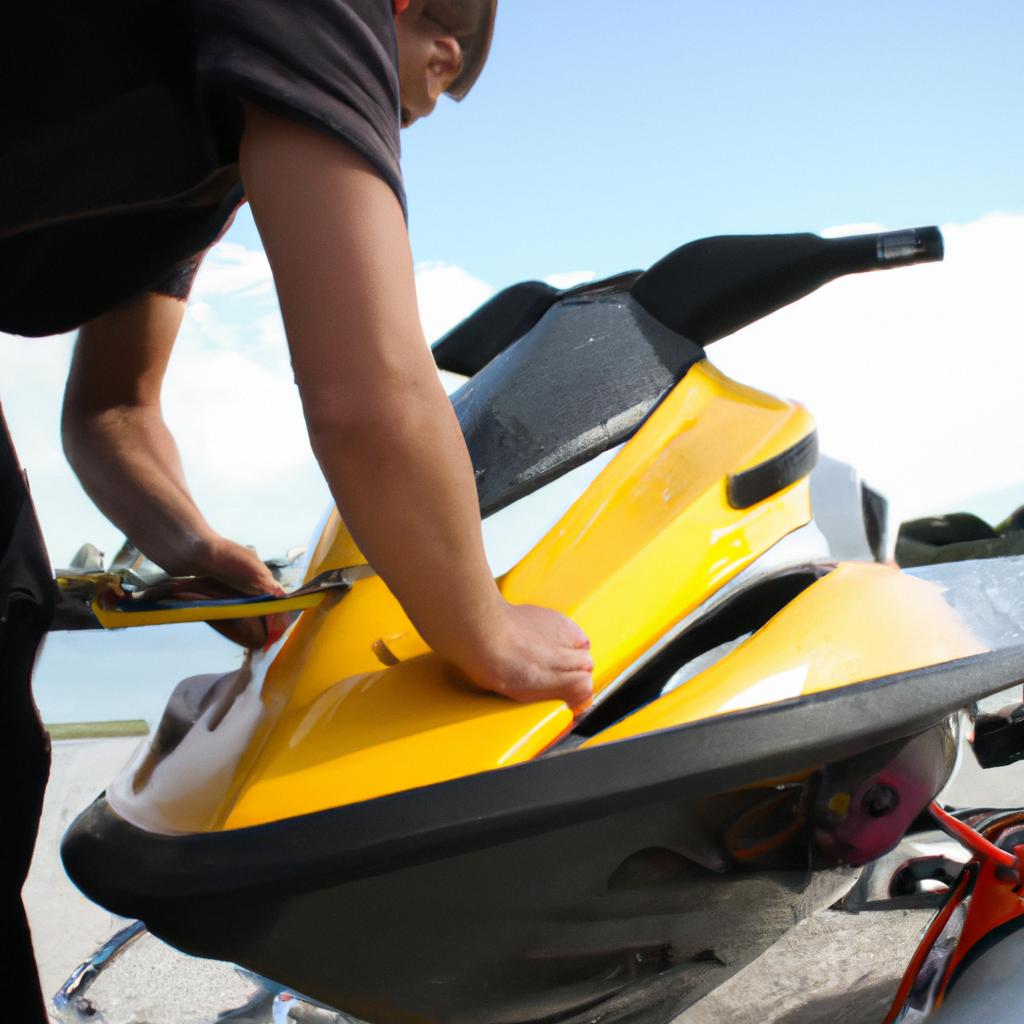Maintenance Tips: Water Sports: Jet Skiing

Jet skiing is a popular water sport that offers excitement and thrill to enthusiasts. Whether one enjoys leisurely rides on calm waters or indulges in adrenaline-pumping stunts, it is essential to prioritize the maintenance of jet skis for optimal performance and safety. This article aims to provide valuable insights into effective maintenance tips for water sports enthusiasts engaging in jet skiing activities.
To illustrate the importance of proper maintenance, let’s consider a hypothetical scenario where John, an avid jet ski rider, neglects regular check-ups and overlooks basic maintenance practices. One sunny afternoon, while cruising at high speeds across the lake, his jet ski suddenly sputters and comes to a halt. Stranded far from shore with no means to reach safety, John’s thrilling adventure quickly turns into a distressing ordeal. Such incidents highlight the significance of regularly inspecting and maintaining key components of a jet ski to ensure uninterrupted enjoyment and avoid potential mishaps or breakdowns on the water.
In this article, we will explore various aspects of jet ski maintenance ranging from engine care to hull cleanliness. By adhering to these recommended practices, riders can extend the lifespan of their equipment, enhance overall performance, and most importantly, guarantee a safe and enjoyable experience while partaking in the exhilar ating sport of jet skiing. So, let’s dive in and discover the essential maintenance tips that every jet ski enthusiast should know.
-
Engine Care:
The engine is the heart of your jet ski, so it is crucial to keep it in top-notch condition. Regularly check the oil levels and change it as per the manufacturer’s recommendations. Additionally, inspect the spark plugs for signs of wear or damage and replace them if necessary. Keep an eye on the cooling system and ensure that there are no blockages or leaks that could lead to overheating. -
Battery Maintenance:
A dead battery can ruin a day of jet skiing fun. To avoid this inconvenience, maintain your battery by checking its charge level regularly and keeping it fully charged when not in use. Clean any corrosion from the terminals using a solution of baking soda and water, ensuring proper electrical connections. -
Fuel System:
Proper fuel system maintenance is essential for optimal performance. Use only high-quality fuel without any ethanol content to prevent damage to your engine. Regularly clean or replace fuel filters according to the manufacturer’s guidelines to ensure efficient fuel flow. -
Hull Inspection:
Inspecting the hull of your jet ski is vital as it directly affects its maneuverability and speed on water. Check for any cracks or damages on both sides of the hull, paying special attention to areas where stress may occur during rides or transport. Repair any issues promptly to prevent further damage. -
Propeller Maintenance:
The propeller plays a critical role in propelling your jet ski through water efficiently. Regularly inspect it for any dings, bends, or debris that may affect performance and cause vibration while riding. If you notice any damage, repair or replace the propeller as needed. -
Trailer Maintenance:
If you transport your jet ski using a trailer, don’t forget about its maintenance too! Inspect tires for proper inflation and tread wear before each trip. Ensure that the trailer lights are working correctly and lubricate moving parts such as hinges, couplers, and winches to prevent rusting and ensure smooth operation.
By following these maintenance tips, jet ski enthusiasts can enjoy a safe and thrilling experience on the water. Regular inspections, timely repairs, and adherence to manufacturer guidelines will help extend the lifespan of your jet ski while ensuring optimal performance. Remember, proper maintenance is key to preventing potential breakdowns or mishaps during your exciting jet skiing adventures. So, keep your jet ski in top shape and make the most out of this exhilarating water sport!
Choosing the right gear for jet skiing
Choosing the Right Gear for Jet Skiing
Imagine this scenario: you’re on a sunny day, gliding across the sparkling water on your jet ski. The wind is in your hair, and the thrill of speed rushes through your veins. However, before embarking on such an exhilarating adventure, it’s crucial to ensure that you have selected the appropriate gear for jet skiing. This section will outline the essential equipment needed for a safe and enjoyable jet skiing experience.
To begin with, one must focus on personal safety by wearing a well-fitted life jacket or personal flotation device (PFD). In case of any mishap or unexpected fall into the water, these devices provide buoyancy and help prevent accidents from turning tragic. Additionally, consider investing in a wetsuit or drysuit to protect yourself against cold temperatures and potential injuries caused by prolonged exposure to water.
Next, safeguarding your feet becomes paramount when participating in water sports like jet skiing. Wearing protective footwear such as neoprene boots not only shields your feet from sharp objects but also provides traction while maneuvering on wet surfaces. Similarly, don’t overlook protecting your eyes from sun glare and flying debris; polarized sunglasses offer both UV protection and improved visibility.
Now let’s explore some additional items that can enhance your jet skiing experience:
- Waterproof phone case: With the advancements in technology, waterproof phone cases allow you to capture amazing moments without worrying about accidental drops or splashes.
- Sunscreen: Apply sunscreen generously before heading out onto the water to shield your skin from harmful ultraviolet rays.
- Waterproof bag: Keep essentials like keys, wallet, and other valuables dry by using a waterproof bag during your excursions.
- First aid kit: It is always wise to be prepared for unforeseen circumstances by carrying a small first aid kit containing basic supplies like bandages and antiseptic ointment.
In summary, selecting the right gear for jet skiing is crucial to ensure your safety and enhance your overall experience. By wearing a well-fitted life jacket or PFD, protective footwear, and utilizing sunglasses, you can mitigate potential risks associated with this thrilling water sport. Moreover, incorporating additional items like a waterproof phone case, sunscreen, waterproof bag, and first aid kit adds convenience and peace of mind during your adventures on the water.
Now that we have explored the importance of choosing appropriate gear for jet skiing let’s move on to understanding how inspecting and cleaning the jet ski before and after use contributes to its longevity and performance.
Inspecting and cleaning the jet ski before and after use
Inspecting and Cleaning the Jet Ski Before and After Use
Imagine this scenario: you’ve just had an exhilarating day of jet skiing out on the open water. The sun is setting, casting a warm glow over the horizon, as you make your way back to shore. As you approach the dock, you notice other jet ski enthusiasts taking care of their equipment before calling it a day. This prompts you to consider the importance of inspecting and cleaning your jet ski both before and after each use.
Before hopping onto your jet ski for another thrilling adventure, it’s essential to thoroughly inspect its condition. A comprehensive inspection involves checking various components such as the hull, engine, fuel system, electrical connections, and steering mechanism. By doing so, potential issues can be identified early on, preventing any unexpected malfunctions while out on the water.
To assist in ensuring a smooth inspection process, here are some key points to keep in mind:
- Check for any signs of wear or damage on the hull.
- Inspect all electrical connections for corrosion or loose wires.
- Examine the fuel system for leaks or blockages.
- Test the steering mechanism to ensure proper functionality.
Once you have completed your inspection and everything appears to be in order, it’s time to give your trusty companion a thorough cleaning. Not only does this help maintain its appearance but also extends its lifespan by removing saltwater residue and debris that could potentially cause corrosion.
Consider these steps when cleaning your jet ski:
- Rinse off any excess saltwater using freshwater from a hose.
- Use a mild detergent specifically formulated for marine vehicles to clean all surfaces.
- Pay special attention to areas prone to buildup such as intake grates and impellers.
- Finish off with a protective wax coating to shield against UV rays and maintain shine.
By making regular inspections and cleanings part of your routine maintenance regimen, you not only enhance performance but also prolong the life of your jet ski. Taking care of your equipment ensures that you can continue to experience the thrill and excitement of jet skiing for years to come.
Now, let’s move on to another crucial aspect of maintaining a jet ski – proper fuel and oil maintenance.
Proper fuel and oil maintenance
Having discussed the importance of inspecting and cleaning your jet ski before and after use, let us now turn our attention to another critical aspect of its maintenance—proper fuel and oil management. By ensuring that you adhere to recommended practices in this regard, you can significantly prolong the lifespan of your watercraft.
Fuel is the lifeblood of any engine-driven vehicle, and a jet ski is no exception. For instance, consider a hypothetical scenario where an individual consistently uses low-quality or contaminated fuel for their jet ski. Over time, this could lead to various issues such as reduced performance, increased fuel consumption, or even engine damage. To avoid these problems, it is crucial to follow these fuel-related maintenance tips:
- Always use high-quality gasoline with the appropriate octane rating.
- Avoid using old or stale fuel; try to consume fresh supplies.
- Refuel at trusted sources to minimize the risk of contamination.
- Store extra fuel properly in approved containers away from direct sunlight.
To further emphasize the significance of proper fuel management, we present a table showcasing potential consequences when neglecting this essential aspect:
| Consequence | Description |
|---|---|
| Reduced Performance | The engine may struggle while accelerating or reaching top speeds. |
| Increased Consumption | Inefficient combustion due to poor-quality fuel leads to higher consumption rates. |
| Engine Damage | Contaminants present in low-grade fuels might cause internal component degradation or failure. |
| Environmental Impact | Negligent disposal practices harm aquatic ecosystems via pollution |
Regularly checking and replacing spark plugs is another fundamental part of maintaining your jet ski’s optimal performance. Spark plugs play a vital role in igniting the air-fuel mixture within the engine cylinders, and worn-out or faulty plugs can result in poor combustion. By following the manufacturer’s recommendations regarding inspection intervals and replacing spark plugs as needed, you ensure consistent ignition and efficient engine operation.
By incorporating these fuel-related maintenance practices into your routine, you actively contribute to the longevity and reliability of your jet ski. In our next section, we will explore the importance of regularly checking and replacing spark plugs to optimize overall performance without compromising safety or efficiency.
Regularly checking and replacing spark plugs
Moving on from properly maintaining the fuel and oil, let us now turn our attention to another crucial aspect of jet ski maintenance – regularly checking and replacing spark plugs. Ignition problems are a common issue faced by jet ski owners, resulting in poor performance or even engine failure. By understanding how to effectively maintain your spark plugs, you can ensure optimal performance and longevity for your watercraft.
Paragraph 1:
To illustrate the importance of spark plug maintenance, consider this hypothetical scenario: You take your jet ski out for a thrilling ride on a sunny day. However, midway through your adventure, you notice a loss of power and sputtering sounds coming from the engine. Worried that something may be seriously wrong with your watercraft, you head back to shore. Upon inspection, it is discovered that dirty or worn-out spark plugs were causing misfires in the engine, leading to the decrease in performance.
In order to avoid such situations and maximize the efficiency of your jet ski’s engine ignition system, here are some key tips for spark plug maintenance:
- Regularly inspecting spark plugs for signs of wear or damage.
- Cleaning dirty spark plugs using appropriate tools and techniques.
- Checking electrode gaps and adjusting them if necessary.
- Replacing old or faulty spark plugs with new ones recommended by the manufacturer.
Bullet Point List (Emotional Appeal):
Maintaining proper spark plug health offers several benefits that enhance both safety and enjoyment while jet skiing:
- Increased fuel efficiency ensures longer rides without worrying about refueling frequently.
- Consistent engine performance allows for smoother acceleration and maneuverability on the water.
- Reduced emissions contribute to preserving the environment and keeping our waterways clean.
- Enhanced reliability reduces unexpected breakdowns during outings, ensuring peace of mind.
Table (Emotional Appeal):
| Benefits of Spark Plug Maintenance |
|---|
| Longer Rides |
| Smoother Acceleration |
| Environmental Conservation |
| Peace of Mind |
Paragraph 2:
By following these maintenance practices, you can significantly extend the life of your jet ski’s spark plugs and prevent potential issues down the line. Regularly checking and replacing spark plugs is a relatively simple task that can be done as part of routine maintenance or when symptoms of ignition problems arise. Taking proactive measures to ensure proper spark plug health will not only save you from future headaches but also contribute to a more enjoyable and trouble-free experience on the water.
Moving forward, let us now delve into another vital aspect of maintaining your jet ski – taking care of its battery.
Maintaining the jet ski’s battery
In addition to regularly checking and replacing spark plugs, another important aspect of jet ski maintenance is ensuring that the battery is properly maintained. Neglecting this crucial component can result in a loss of power or even complete failure during your water sports adventures.
Battery Maintenance Importance:
To highlight the significance of maintaining the jet ski’s battery, let us consider an example. Imagine you are out on a sunny summer day, ready to embark on an exhilarating ride across the waves. However, as soon as you attempt to start your jet ski, you realize that the battery is dead. This unfortunate situation not only ruins your plans but also leaves you stranded far from shore. To avoid such distressing experiences, it is essential to prioritize proper battery maintenance.
Tips for Jet Ski Battery Maintenance:
To ensure optimal performance and longevity of your jet ski’s battery, follow these helpful tips:
- Disconnect the battery when not in use: If you anticipate leaving your jet ski unused for an extended period, disconnecting the battery will prevent any drain caused by electrical systems or potential leaks.
- Clean and inspect connections regularly: A build-up of corrosion on terminals can impede electrical flow and reduce the efficiency of your battery. Regularly cleaning and inspecting connections minimizes this risk.
- Check electrolyte levels: Some batteries require periodic monitoring of electrolyte levels (acid-water ratio). Ensuring they are at appropriate levels helps maintain battery health.
- Store the jet ski with a fully charged battery: Before storing your jet ski away for a prolonged period, charge the battery completely. Doing so prevents self-discharge and keeps it ready for future use.
- Peace of mind knowing your jet ski will always have sufficient power
- Avoidance of unexpected breakdowns while enjoying water sports activities
- Increase in overall safety during rides due to consistent power supply
- Extended battery life, reducing the need for premature replacements
Emotional Table:
| Battery Maintenance Benefits |
|---|
| Increased Reliability |
| Enhanced Performance |
| Longevity |
| Peace of Mind |
By diligently maintaining your jet ski’s battery, you can ensure a smooth and uninterrupted experience on the water. However, proper maintenance does not end here. It is equally important to store your jet ski correctly when not in use, which we will explore in the following section.
Storing the jet ski correctly when not in use
Maintaining the jet ski’s battery is crucial for ensuring optimal performance and longevity. Neglecting proper battery maintenance can lead to issues such as a dead battery or reduced power output during water sports activities like jet skiing. To prevent these problems, it is important to follow a few key maintenance tips.
Firstly, always keep your jet ski’s battery charged when not in use. This helps to maintain its overall health and prevents it from draining completely. A fully charged battery will also ensure that you have enough power for an uninterrupted ride on the water. For example, let’s consider a scenario where neglecting to charge the battery leads to an unexpected shutdown while jet skiing, leaving you stranded far from shore.
Secondly, regularly inspect the battery terminals for any signs of corrosion or damage. Corroded terminals can hinder proper electrical connections and reduce the efficiency of your jet ski’s battery. In case of corrosion, clean the affected areas with a mixture of baking soda and water using a wire brush or abrasive pad. By doing this, you’ll avoid potential starting issues caused by poor terminal contact.
Lastly, store your jet ski’s battery in a cool and dry location when not in use. Extreme temperatures can negatively impact the lifespan of the battery. Exposure to excessive heat can cause electrolyte evaporation and decrease overall performance levels over time. On the other hand, storing the battery in extremely cold conditions can result in reduced capacity and difficulty starting up during colder seasons.
To summarize:
- Keep your jet ski’s battery charged when not being used.
- Regularly inspect and clean the terminals for any signs of corrosion.
- Store the battery in a cool and dry place away from extreme temperatures.
By following these maintenance tips, you can extend the life of your jet ski’s battery and enjoy trouble-free rides out on the water.
- Ensure worry-free riding experiences
- Maximize fun-filled adventures
- Avoid unexpected breakdowns
- Prolong battery lifespan and save on replacement costs
Emotional Table:
| Benefits of Proper Battery Maintenance |
|---|
| 1. Peace of mind |
| 2. Enhanced performance |
| 3. Cost savings |
| 4. Longevity |
Remember, maintaining your jet ski’s battery is essential for a seamless water sports experience. By implementing these tips, you can avoid unnecessary setbacks and enjoy exhilarating rides on the open water.







